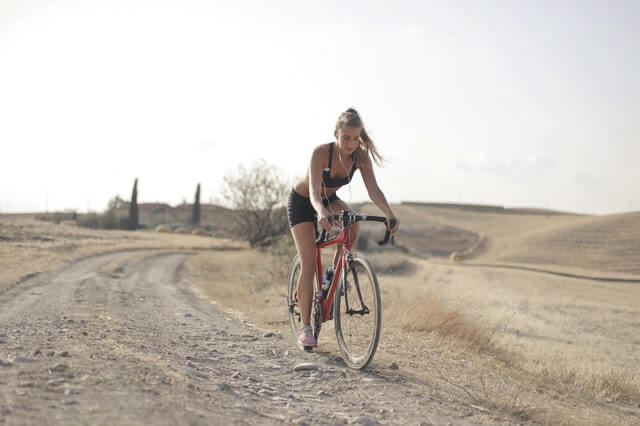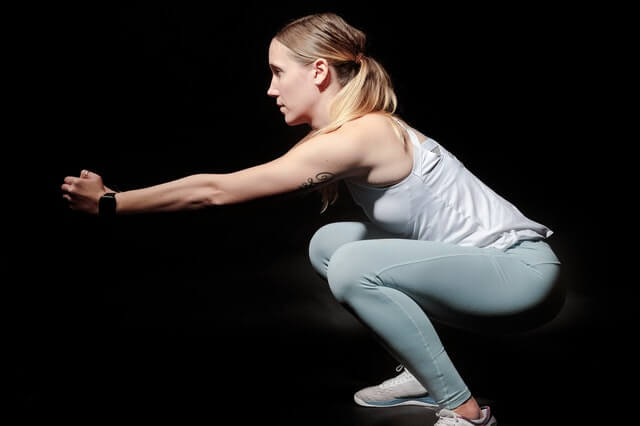Strength training cycling: For many this is still a contradiction in itself. Biking is an endurance sport, while in the weight room you focus on muscle growth. Nevertheless, you can benefit sustainably from combined training. It's not for nothing that many professional bikers do a targeted strength training program in winter to define or build muscles.
Read here 4 effective exercises with which you can complete and optimize your strength training for cycling. We will also tell you what role amino acids play for cyclists .

Performance-enhancing strength exercises
Strengthening the leg muscles plays a dominant role in cycling . Undoubtedly, the leg muscles also have to do the heavy, strenuous work of cycling. But truly performance-enhancing strength training also includes the upper body in the training.
There's a reason for that.
The upper body muscles are the decisive factor in giving your body stability and keeping it balanced. In addition, trained and strong upper body muscles counteract the force developed by the lower body muscles against the pedals . Muscle strength helps to better compensate for shocks. Especially if you are traveling off-road on a crosser or a gravel bike.

Prevent the loss of muscle mass
Muscle training is also worthwhile from a preventive perspective. Through targeted muscle building training - just like strength training in triathlons - you can prevent possible imbalances and muscular deficits that occur in cyclists, especially at the end of the season. Cyclists sometimes lose a lot of upper body muscle in this regard. And not only that.
The maximum strength of the legs also sometimes decreases significantly by the end of the season. You can counteract this loss of muscle strength with targeted strength exercises. Simply training your endurance is not enough here. The endurance training that dominates cycling in no way replaces the high level of stimulation that strength training exercises provide.
What is productive muscle training for cyclists?
The problem is that many professional and semi-professional cyclists still see muscles as useless body mass. Muscles are therefore nothing more than unnecessary weight that they carry up the mountain as an additional burden. That's why many cyclists are still skeptical about intensive strength exercises today.
It is not for nothing that the benefits of strength training in cycling have been controversially discussed for many years. However, concerns about gaining too much muscle mass and therefore weight through strength training exercises appear to be unfounded.
Proponents of targeted muscle training as a supplement to classic training for cyclists argue that building voluminous muscle is not possible at all. On the one hand, the frequency, scope and intensity of strength training exercises are not sufficient. On the other hand, intensive endurance training inhibits the training effects responsible for muscle building .
This is comparable to strength training in triathlons. Instead, performance-enhancing effects of around six to ten percent were observed in this context through the combination of strength and endurance training (cf. Wagner, Mühlenhoff et al. 2017).
It is also clear that muscle training does not have a negative effect on endurance. Studies have also been able to largely prove this. Rather, it is scientifically proven that performance reserves can be increased with specific strength exercises for cycling (see Janßen " Strength training in endurance sports ", 2013)
Can the athlete also do strength exercises on the bike?
Cyclists generally train a lot of strength endurance. However, special training methods to increase strength endurance or improve resistance to fatigue are rarely used.
Ambitious cyclists achieve the necessary training effects through targeted interval training. In this case , additional strength endurance training is not necessary.
Cycling strength training for muscle growth is increasingly aimed at increasing the muscle cross-section. This is called hypertrophy training . The so-called intramuscular coordination training (IK training) also serves to increase strength or muscle growth.
You should do strength exercises in the weight room
You generally have to complete your strength training exercises in the weight room, or at least with the appropriate equipment. Strength exercises are not possible on the bike itself . Many cyclists assume that even powerful riding with large gear ratios acts as strength training. That is a mistake.
In order to be able to define muscles , the amount of force produced is not high enough. Therefore, these are not physiological adaptations in the sense of classic strength training exercises. Rather, such methods represent intensive endurance training in which the focus is on the aerobic provision of energy.
For ambitious cyclists, the most suitable exercises to increase muscle strength are complex barbell exercises such as deadlifts, squats and bench presses .

How to make your strength training for cycling effective?
The same applies to cyclists : A strength training program must always be individually tailored. It is also important that you continuously optimize the training content and adapt it to your training progress. A suitable training plan forms the basis for this.
But without your own commitment and the willingness to do strength exercises regularly and over a longer period of time, it won't work. Only if you actually show full commitment to the strength exercises will you benefit from the positive effects of strength training on the bike. If you lack will and motivation, it will be difficult for your muscles to grow.
Because without enough stimuli, a muscle cannot grow. In order to gain volume, your muscles need to be overwhelmed to some degree during exercise. This strain causes the muscle to tire. In addition, so-called microtraumas occur. These are minor muscle fiber injuries.
If you are in the recovery phase after the strength exercises, your body repairs the muscle fibers again. This happens through the storage of new proteins that act as building materials for the muscles. The proteins not only repair the fibers of the muscles , but also strengthen them. In this way, the muscles are adjusted to the new stresses. This procedure is repeated after every training session, which causes the muscles to grow.
These strength exercises are considered particularly effective in cycling
Are you ready for a training session? We have the right training tips for you! With the following exercises you will build strength and improve your performance on the bike.
1. Deadlift
This exercise primarily works your thighs, buttocks and lower back. The deadlift also stresses the shoulders, neck, stomach and calves and strengthens grip strength. This has an effective effect on your muscle strength. This makes key movements on the bike easier for you, which also benefits efficiency and speed.
How does the deadlift work ?
- Starting position : shoulder-width apart and with knees slightly bent
- Adopt the correct grip position : left and right of the shins; Palms facing you
- Raising the barbell : shoulder blades back; breathe in; Keep your back straight and bring tension into your stomach; then raise dumbbell to hip height; Push your pelvis forward; exhale.
- Lowering the barbell : Bring your pelvis back to the starting position; knees slightly bent; Bring the dumbbell close to your legs
We recommend : 4 sets of 8 repetitions each; 45 to 60 seconds rest between sets.
It is important that your body remains in tension throughout the training and that you move the dumbbell close to your body in a fluid movement. You can also vary the exercise. To do this, change the width of your stance and use a trap bar, rack or kettlebell.
2. Push-up jumps (burpee)
This is a combination of push-ups and stretch jumps . With this exercise you train your legs, buttocks, back, stomach, shoulders, chest, hips and triceps particularly strongly. Basically, training uses almost all muscles .
In addition, push-up jumps have positive effects on endurance, burn calories and increase your heart rate. The exercise consists of a squat, a push-up and a stretch jump.
How do push-up jumps work ?
- Starting position : squatting, shoulder-width apart; hands on the floor; Fingers point away from the body
- Do a push-up, then jump your feet toward your hands to land back in a squat.
- Now jump up, stretch your legs straight down and your arms up
- Jump your feet back and assume the push-up position again
We recommend : 3 sets of 10 reps; 60 seconds rest between sets.
You can also vary the exercise. For example, while you are in the push-up position, you can incorporate a short push-up. To protect your knees, we recommend doing half push-up jumps . To do this, pull your legs one after the other towards your hands and avoid jumping out of the push-up position.
Or put an obstacle in front of you that you jump over instead of doing the stretch jump.
3. Squats
Squats are a basic exercise in strength training and one of the most important exercises for cyclists. The training effect is primarily aimed at the thigh muscles. In addition, squats also strain the glutes, back and abdominal muscles.
Since the knees, joints and hips are also involved, with this training you not only improve your muscle strength, but also increase your athleticism and flexibility.
How do classic squats work ?
- Starting position : hip-width stance; Knees slightly bent
- Bend your knees and push your hips back; Take a sitting position
- Assume a sitting position, feet always flat on the floor
- perform upward and downward movement; It is essential to avoid hunching your back
- Inhale when moving downwards and exhale when moving upwards
We recommend : 3 sets of 10 reps; 90 to 120 seconds rest between sets.
Squats can be trained with your own body weight or with additional weights. Use a barbell bar and position it on the back of your shoulder girdle or in your neck . Alternatively, you can hold small dumbbells or kettlebells in your hands as they move up and down.
A knee-friendly variant is the front squat, in which the barbell rests on the front shoulder head.

4. Bench press
With bench presses you primarily train the upper body muscles, which cyclists use primarily for cornering technique and on bumps and descents. The training particularly targets the chest muscles, triceps and front shoulder muscles. You train your upper back and abdominal muscles in proportion.
How does the bench press work:
- Starting position : lie on your back on the flat bench; Your eyes are at the level of the barbell, feet firmly on the floor or alternatively cross your lower legs
- Grab the dumbbell bar, basic position, upper and forearms form an approximately 90 degree angle at the elbows.
- tense your stomach and back muscles; shoulder blades backwards; then lower the dumbbell to chest height
- Take a short break and then press the weight upwards with force; Arms stretched, but not straight
- Immediately initiate the backward movement at the highest point
We recommend: 5 sets of 5 reps; 60 seconds rest between sets
The exercise can be varied. This works by changing the angle of the bench or the width of the handle. Or you can use dumbbells instead of barbells. If you don't have a weight bench, lie on the floor to press the dumbbells up. However, with this variant you use less muscle. Some strength athletes also use TRX bands .

Amino acids as a crucial factor for strength training in cycling
Are your muscles burning now? Sweat is pouring and your heart is pumping? Then you have trained really intensively and your body now needs rest and regeneration . He needs new power on the bike so that his muscles grow. Eating after exercise is very important.
The supply of proteins and therefore amino acids is particularly important. These act as building blocks for all proteins and are vital for the human body. Without amino acids, neither fat burning nor muscle building is possible. Athletes in particular who regularly reach their limits on their bikes and in the weight room should specifically supply themselves with the essential amino acids .



